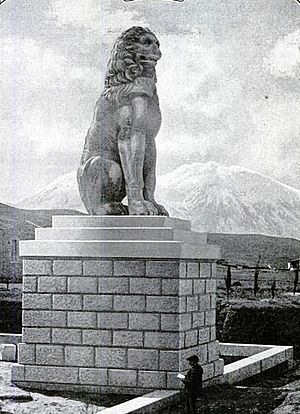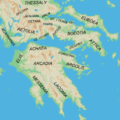Sacred Band of Thebes facts for kids
The Sacred Band of Thebes was a special group of soldiers in the ancient Theban army. They were active in the 4th century BC. This unit was made up of 150 pairs of men who were very close companions. People believed that men who had strong bonds with each other would fight better. They would be brave and protect each other in battle.
The Greek writer Plutarch (who lived from 46 to 120 AD) wrote the most detailed story about the Sacred Band. In his book Life of Pelopidas, Plutarch explained their bravery. He said that these men would "willingly rush into danger" for their companions. They would feel ashamed to act poorly in front of those they cared about.
The Theban commander Gorgidas is said to have formed the Sacred Band in 378 BC. At first, these pairs of men were spread out in the army. Later, it was decided to put them all together into one special squad. This squad became very important.
Contents
The Sacred Band's Role in Battle
The Sacred Band played a key part in several important battles. Their unique structure made them a very strong fighting force.
Battle of Leuctra
One of their most famous victories was at the Battle of Leuctra in 371 BC. In this battle, the Theban army fought against the powerful Spartan army. The Sacred Band, led by the general Pelopidas, helped the Thebans win a surprising victory. This win showed how effective their close-knit fighting style was. It also ended Sparta's long-standing power in Greece.
The Final Stand at Chaeronea
The Sacred Band fought its last battle in 338 BC. This was the Battle of Chaeronea, where they faced Philip II of Macedon and his strong Macedonian army. The Sacred Band fought bravely, but they were completely destroyed. They refused to surrender and fought to the very end. This battle marked the end of Theban power and the rise of Macedon.
Images for kids
-
The ruins of ancient Theban citadel of Cadmea
-
A statue of the boeotarch Epaminondas, who was widely hailed for his brilliant and revolutionary tactics in the Battle of Leuctra
-
Plutarch's Lives (pictured: the 1727 edition of the English translation by André Dacier) is the main source for the most substantial surviving account of the Sacred Band. It is believed to be mostly based on the works of the Sacred Band's contemporaries Callisthenes and Ephorus. Unfortunately the works of the latter two have been lost to history.
See also
 In Spanish: Batallón Sagrado de Tebas para niños
In Spanish: Batallón Sagrado de Tebas para niños









